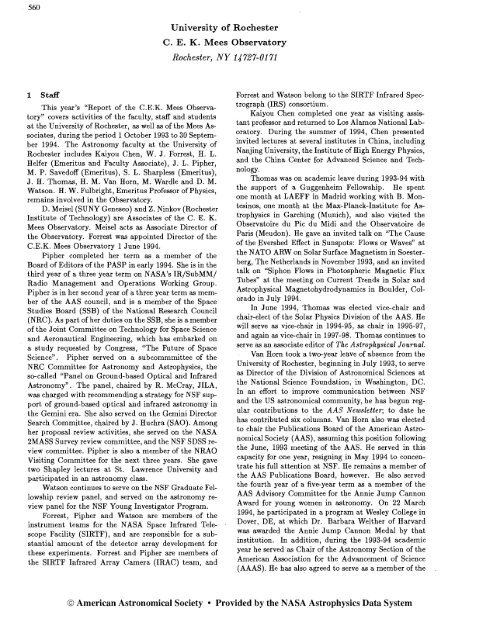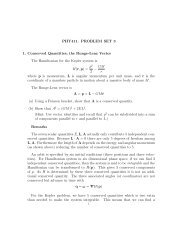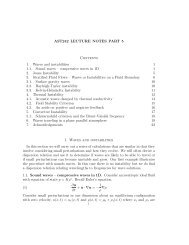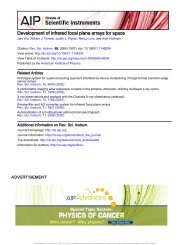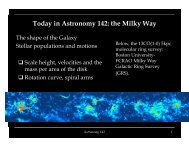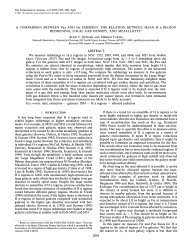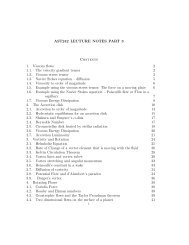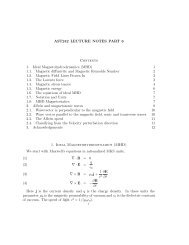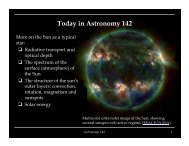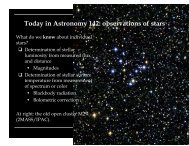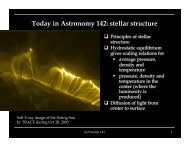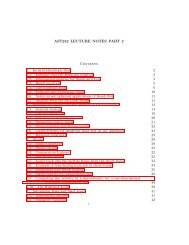University of Rochester C. E. K. Mees Observatory - Astro Pas ...
University of Rochester C. E. K. Mees Observatory - Astro Pas ...
University of Rochester C. E. K. Mees Observatory - Astro Pas ...
You also want an ePaper? Increase the reach of your titles
YUMPU automatically turns print PDFs into web optimized ePapers that Google loves.
<strong>University</strong> <strong>of</strong> <strong>Rochester</strong>C. E. K. <strong>Mees</strong> <strong>Observatory</strong><strong>Rochester</strong>, NY 14727-01 71This year's "Report <strong>of</strong> the C.E.K. <strong>Mees</strong> <strong>Observatory</strong>"covers activities <strong>of</strong> the faculty, staff and studentsat the <strong>University</strong> <strong>of</strong> <strong>Rochester</strong>, as well as <strong>of</strong> the <strong>Mees</strong> Associates,during the period 1 October 1993 to 30 September1994. The <strong>Astro</strong>nomy faculty at the <strong>University</strong> <strong>of</strong><strong>Rochester</strong> includes Kaiyou Chen, W. J. Forrest, H. L.Helfer (Emeritus and Faculty Associate), J. L. Pipher,M. P. Saved<strong>of</strong>f (Emeritus), S. L. Sharpless (Emeritus),J. H. Thomas, H. M. Van Horn, M. Wardle and D. M.Watson. H. W. Fulbright, Emeritus Pr<strong>of</strong>essor <strong>of</strong> Physics,remains involved in the <strong>Observatory</strong>.D. Meisel (SUNY Geneseo) and Z. Ninkov (<strong>Rochester</strong>Institute <strong>of</strong> Technology) are Associates <strong>of</strong> the C. E. K.<strong>Mees</strong> <strong>Observatory</strong>. Meisel acts as Associate Director <strong>of</strong>the <strong>Observatory</strong>. Forrest was appointed Director <strong>of</strong> theC.E.K. <strong>Mees</strong> <strong>Observatory</strong> 1 June 1994.Pipher completed her term as a member <strong>of</strong> theBoard <strong>of</strong> Editors <strong>of</strong> the PASP in early 1994. She is in thethird year <strong>of</strong> a three year term on NASA's IR/SubMM/Radio Management and Operations Working Group.Pipher is in her second year <strong>of</strong> a three year term as member<strong>of</strong> the AAS council, and is a member <strong>of</strong> the SpaceStudies Board (SSB) <strong>of</strong> the National Research Council(NRC). As part <strong>of</strong> her duties on the SSB, she is a member<strong>of</strong> the Joint Committee on Technology for Space Scienceand Aeronautical Engineering, which has embarked ona study requested by Congress, "The Future <strong>of</strong> SpaceScience". Pipher served on a subcommmittee <strong>of</strong> theNRC Committee for <strong>Astro</strong>nomy and <strong>Astro</strong>physics, theso-called "Panel on Ground-based Optical and Infrared<strong>Astro</strong>nomy". The panel, chaired by R. McCray, JILA,was charged with recommending a strategy for NSF support<strong>of</strong> ground-based optical and infrared astronomy inthe Gemini era. She also served on the Gemini DirectorSearch Committee, chaired by J. Huchra (SAO). Amongher proposal review activities, she served on the NASA2MASS Survey review committee, and the NSF SDSS reviewcommittee. Pipher is also a member <strong>of</strong> the NRAOVisiting Committee for the next three years. She gavetwo Shapley lectures at St. Lawrence <strong>University</strong> andparticipated in an astronomy class.Watson continues to serve on the NSF Graduate Fellowshipreview panel, and served on the astronomy reviewpanel for the NSF Young Investigator Program.Forrest, Pipher and Watson are members <strong>of</strong> theinstrument teams for the NASA Space Infrared TelescopeFacility (SIRTF), and are responsible for a substantialamount <strong>of</strong> the detector array development forthese experiments. Forrest and Pipher are members <strong>of</strong>the SIRTF Infrared Array Camera (IRAC) team, andForrest and Watson belong to the SIRTF Infrared Spectrograph(IRS) consortium.Kaiyou Chen completed one year as visiting assistantpr<strong>of</strong>essor and returned to Los Alamos National Laboratory.During the summer <strong>of</strong> 1994, Chen presentedinvited lectures at several institutes in China, includingNanjing <strong>University</strong>, the Institute <strong>of</strong> High Energy Physics,and the China Center for Advanced Science and Technology.Thomas was on academic leave during 1993-94 withthe support <strong>of</strong> a Guggenheim Fellowship. He spentone month at LAEFF in Madrid working with B. Montesinos,one month at the Max-Planck-Institute for <strong>Astro</strong>physicsin Garching (Munich), and also visited theObservatoire du Pic du Midi and the Observatoire deParis (Meudon). He gave an invited talk on L'The Cause<strong>of</strong> the Evershed Effect in Sunspots: Flows or Waves'' atthe NATO ARW on Solar Surface Magnetism in Soesterberg,The Netherlands in November 1993, and an invitedtalk on "Siphon Flows in Photospheric Magnetic FluxTubes" at the meeting on Current Trends in Solar and<strong>Astro</strong>physical Magnetohydrodynamics in Boulder, Coloradoin July 1994.In June 1994, Thomas was elected vice-chair andchair-elect <strong>of</strong> the Solar Physics Division <strong>of</strong> the AAS. Hewill serve as vice-chair in 1994-95, as chair in 1995-97,and again as vice-chair in 1997-98. Thomas continues toserve as an associate editor <strong>of</strong> The <strong>Astro</strong>physacal Journal.Van Horn took a two-year leave <strong>of</strong> absence from the<strong>University</strong> <strong>of</strong> <strong>Rochester</strong>, beginning in July 1993, to serveas Director <strong>of</strong> the Division <strong>of</strong> <strong>Astro</strong>nomical Sciences atthe National Science Foundation, in Washington, DC.In an effort to improve communication between NSFand the US astronomical community, he has begun regularcontributions to the AAS Newsletter; to date hehas contributed six columns. Van Horn also was electedto chair the Publications Board <strong>of</strong> the American kstronomicalSociety (AAS), assuming this position followingthe June, 1993 meeting <strong>of</strong> the AAS. He served in thiscapacity for one year, resigning in May 1994 to concentratehis full attention at NSF. He remains a member <strong>of</strong>the AAS Publications Board, however. He also servedthe fourth year <strong>of</strong> a five-year term as a member <strong>of</strong> theAAS Advisory Committee for the Annie Jump CannonAward for young women in astronomy. On 22 March1994, he participated in a program at Wesley College inDover, DE, at which Dr. Barbara Welther <strong>of</strong> Harvardwas awarded the Annie Jump Cannon Medal by thatinstitution. In addition, during the 1993-94 academicyear he served as Chair <strong>of</strong> the <strong>Astro</strong>nomy Section <strong>of</strong> theAmerican Association for the Advancement <strong>of</strong> Science(AAAS). He has also agreed to serve as a member <strong>of</strong> theO American <strong>Astro</strong>nomical SocietyProvided by the NASA <strong>Astro</strong>physics Data System
UNIVERSITY OF ROCHESTER 561International Scientific Committee for the InternationalConference on the Physacs <strong>of</strong> Strongly Coupled Plasmas,to be held in Binz/Rugen, Germany, in September 1995.Van Horn presented several invited lectures in 1993-94. He spoke on "Equations <strong>of</strong> State in Stellar Structureand Evolution" at IAU Colloquium 147, in St.Malo,France, on 14 June 1993 (Van Horn 1994), on "ThePhysics <strong>of</strong> White Dwarfs" at the 9th APS Topical Conferenceon Atomic Processes in Plasmas, in San Antonio,TX, on 20 September 1993, and on "Global Oscillations<strong>of</strong> Neutron Stars as Potential Probes <strong>of</strong> MicroscopicPhysics at Ultra-High Densities" at the International OjiSeminar, in Tomakomai, Japan, on 28 June 1994 (VanHorn ei al. 1994).Thomas and Van Horn completed the third year <strong>of</strong>their NASA Theory Grant, on "The Seismology <strong>of</strong> Rotating,Magnetic Stars," which supports the research <strong>of</strong>their joint astrophysics theory group. The research program<strong>of</strong> this group includes investigations <strong>of</strong> oscillationsand other physical properties <strong>of</strong> the Sun, giant planets,"brown dwarfs," white dwarfs, accretion and "excretion"disks, neutron stars, and astrophysical jets.Wardle joined the faculty effective July 1993, but remainedat Northwestern <strong>University</strong> on leave during thefall semester <strong>of</strong> 1993. He moved to <strong>Rochester</strong> in January1994. While at Northwestern he continued collaborationswith F. Yusef-Zadeh and A. Konigl (U. Chicago).In addition to their collaborative research, Wardle andYusef-Zadeh are co-writing a book about the GalacticCenter for Cambridge <strong>University</strong> Press.Helfer <strong>of</strong>ficially retired as <strong>of</strong> 1 July 1992 but remainsactive in the Department. He served as <strong>Rochester</strong>'s representativeon the Board <strong>of</strong> Directors <strong>of</strong> the New York<strong>Astro</strong>nomical Corporation.Ninkov continues studies into the development <strong>of</strong>charge injection devices under the auspacies <strong>of</strong> a NationalScience Foundation Industry <strong>University</strong> Cc-operativeResearch Center (IUCRC) and a New York StateCenter for Advanced Technology (CAT) grant whichsupports the activities <strong>of</strong> faculty participants in the Institute<strong>of</strong> Optics, Department <strong>of</strong> Electrical Engineering,Department <strong>of</strong> Physics & <strong>Astro</strong>nomy, and the Center forImaging Science at RIT.In November, 1993, postdoc Umin Lee left the <strong>University</strong><strong>of</strong> <strong>Rochester</strong> to accept a position at the EcoleNormale Superieure, in Lyon, France. Dr. Lee is continuinghis collaboration with <strong>Rochester</strong> astronomers, completinga study with Van Horn <strong>of</strong> the global oscillationmodes potentially excitable during the impacts <strong>of</strong> fragments<strong>of</strong> Comet Shoemaker-Levy 9 with Jupiter. In addition,he is currently finishing work on the effects <strong>of</strong>superfluidity upon the global oscillation modes <strong>of</strong> neutronstars in collaboration with Richard Epstein (LosAlamos), Tim Collins (<strong>Rochester</strong>), and Van Horn.Research Associate Fran~ois PichC left the near IRgroup in June 1994 after a 1112 year stay. He has taken aposition at the <strong>University</strong> <strong>of</strong> Cambridge, UK and will bedeveloping new instrumentation to avoid the OH emissionbands in the near IR. He continues to collaboratewith the near IR group in his studies <strong>of</strong> the outflows fromYoung Stellar Objects, such as L1157.Alexander G. Muslimov completed his second yearas a research associate and instructor in July 1994, withsupport from an NSF grant. During the academic year1994-95 he will continue as Assistant Pr<strong>of</strong>essor. In June1995 he will move to the Institut fur <strong>Astro</strong>physik und ExtraterrestrischeForschung der Universitat, Bonn (Germany)with the support <strong>of</strong> a Humboldt fellowship.Jian Wu, a doctoral candidate in the EE department,completed his first year with the near IR groupthis past year as a part time engineer and scientist. He isresponsible for the test and evaluation <strong>of</strong> 5 micron cut<strong>of</strong>fHgCdTe 256 x 256 arrays from Rockwell Thousand OaksScience Center.Bradley Marazas is in his third year as Engineer withthe group.Hans Deeg joined the detector group at RIT inSeptember 1993 after completing his PhD in <strong>Astro</strong>physicsat the <strong>University</strong> <strong>of</strong> New Mexico. He is stuydingthe performance <strong>of</strong> CCD arrays and the IMF <strong>of</strong> youngclusters.William Cirillo joined the detector group at RIT asan Associate Scientist with principal responsibilities beingthe development <strong>of</strong> camera control s<strong>of</strong>tware.Peter Wilson (<strong>University</strong> <strong>of</strong> Sydney) was a visitingscientist in the department in August 1994, workingon problems in helioseismology and the solar cycle withThomas.Charles Gammie (U. Virginia) visited for two weeksin June 1994, working on aspects <strong>of</strong> ambipolar diffusionin the interstellar medium with Wardle.Kevin McFadden is in his third year as Programmer/Analystwith the Near IR group.Public tours were conducted at the <strong>Observatory</strong>from June until the end <strong>of</strong> August by several undergraduateemployees: Rob Armstrong, Ronian Siew, TammyMiddleton, and Craig McMurtry. We are indebted toMarilee Kaye Montanaro for her excellent handling <strong>of</strong>tour arrangements and public relations for the <strong>Observatory</strong>,and to Kurt Holmes, carrying on in his father's finetradition as <strong>Observatory</strong> Supervisor.Marilee Kaye Montanaro, Administrative ResearchCoordinator for <strong>Astro</strong>nomy, has efficiently handled themany administrative tasks for the group.2 Undergraduate EducationIn the second year <strong>of</strong> an NSF ILI grant, Meisel continuedwork using portable CCD cameras in elementaryastronomy laboratories. A paper describing the first yearresults was given in the Education session <strong>of</strong> the American<strong>Astro</strong>nomical Society meeting in Washington D.C.,January 1994 (Meisel, Showers, Lang, et al. 1994). Thisin turn led to an invitation to do a 112 hour presentationbefore the National meeting <strong>of</strong> the American Association<strong>of</strong> Physics Teachers at Notre Dame in August '94. Theproject has also led to the collaborative development <strong>of</strong>astronomy laboratory exercises with two observatoriesand others are expected in the future.O American <strong>Astro</strong>nomical SocietyProvided by the NASA <strong>Astro</strong>physics Data System
562 ANNUAL REPORTSJames Muzerolle worked with the far-infrared astronomygroup this year, and wrote a senior thesis entitled"Infrared spectroscopy <strong>of</strong> shocks in the DR21 andCepheus A molecular outflows," under Watson's direction.On the strength <strong>of</strong> this work he was runner-up inour department's annual Stoddard Prize competition.Senior undergraduate Tammy Middleton joined Watson'sgroup in the summer <strong>of</strong> 1994. She has been workingwith Raines and Watson on characterization <strong>of</strong> farinfrareddetectors and arrays.Craig McMurtry completed his senior thesis "NearInfrared Observations <strong>of</strong> the Star Formation RegionAFGL 6336 S" under Forrest. It was based on near IRimages acquired at the 1.5m Mount Lemmon ObservingFacility. He has begun graduate work in the PhysicsDepartment at U. Wyoming and is working for C.E.Woodward there. He continues to collaborate with theIR group during observing runs at the 2.3m WyomingInfrared <strong>Observatory</strong>.Bernie Sklanka completed his senior thesis "A NearInfrared Study <strong>of</strong> the BFS 56 Star Formation Region"under Forrest. He also wrote "An Overview <strong>of</strong> ObservationalTechniques for C.E. Kenneth <strong>Mees</strong> <strong>Observatory</strong>and the Santa Barbara Instrumentation Group ST-6CCD Camera" which described his experiences imagingthe S 106 in the Ha line. He has gone to graduate schoolin Engineering at Penn State.Craig McMurtry, Bernie Sklanka, Abbas Tahir, RobArmstrong, and Ronian Siew worked in the near IR labover the summer <strong>of</strong> 1994. They helped develop new IRinstrumentation and organized the IR observational database. McMurtry and Sklanka also took part in the testingand evaluationpf 256 x 256 InSb and HgCdTe arraysunder the supervision <strong>of</strong> Brad Marazas and JianWu. Abbas began the design in Zemax and AutoCAD<strong>of</strong> the cross-dispersed 1-5 micron echelette spectrometer(Xchel) .Undergrads Armstrong and Siew, along with gradstudents Jennifer Goetz and David May used the upgradedST-4X SBIG CCD camera at the 14" Wilmotobservatory to record the appearance <strong>of</strong> Jupiter in red,green, and blue bands during its collision with cometShoemaker/Levy in July 1994. Dark spots correspondingto impact sites were detected.A1 Pieterman spendt the summer <strong>of</strong> 1994 using theRIT 2kx2k CCD camera at the <strong>Mees</strong> <strong>Observatory</strong> studyingthe limits to accurate photometry <strong>of</strong> selected fields.He is continuing his efforts in his senior year at the Centerfor Imaging Science at RIT.3 Graduate EducationJohn Bloomer, Matt Guptill, Nick Raines and ShobitaSatyapal are graduate students in the Far InfraredGroup, working with Watson on far-infrared detector developmentfor SIRTF, imaging far-infrared spectrometerdevelopment, and infrared and millimeter wave spectrallineimagery <strong>of</strong> galaxies.Matt Guptill has taken a year's leave from his NASAGraduate Researchers Fellowship in Watson's group inorder to spend a year working at Rockwell (Anaheim).At Rockwell he is involved in the epitaxial growth andprocessing <strong>of</strong> Ge:Ga BIB far-infrared detector arrays, underJim Huffman's direction. His presence at Rockwellhas boosted considerably the detector fabrication activities<strong>of</strong> the <strong>Rochester</strong>-Rockwell-JPL collaboration responsiblefor the development <strong>of</strong> these devices for SIRTF,and has provided him the opportunity <strong>of</strong> including everyaspect <strong>of</strong> building, testing and using the arrays inhis thesis.Tim Collins completed his research on the effects <strong>of</strong>superfluidity on nonradial spheroidal oscillations <strong>of</strong> neutronstars, in collaboration with Van Horn, Lee, and R.Epstein (Los Alamos). He presented a poster paper onthis work at the 184th meeting <strong>of</strong> the AAS (Collins et a1.1994). Collins also began his Ph.D. thesis research, investigatingthe boundary layers <strong>of</strong> accretion disks aroundwhite dwarfs in cataclysmic binaries. This research examinesthe possibility that quasiperiodic oscillations anddwarf-nova oscillations might both be driven by instabilitiesin the boundary layer. To this end he has createdsteady-state boundary layer and disk models in the fashion<strong>of</strong> both Lightman (1974) and Lioure and Le Contel(1994)' and is currently investigating the stability <strong>of</strong> theboundary layer. This work is being supervised jointly byVan Horn and Wardle.Guy Delamarter completed his first year <strong>of</strong> graduatestudy and his work with Van Horn on core formation interrestrial planets. He is now working with Wardle onshock waves in molecular clouds.J. Andrew Markiel is conducting his Ph.D. thesisresearch with Thomas and Van Horn, studying timedependentdynamo models operating in the surface convectionzones <strong>of</strong> white dwarfs. The goal <strong>of</strong> this research isto determine the conditions under which this process cangenerate magnetic fields with the strength and variabilitytimescale, e.g., which are inferred from the observations<strong>of</strong> GD 358 (Winget et al. 1994). The preliminary resultsappear very promising, and the three investigatorshave recently published a short paper describing them(Markiel, Thomas, and Van Horn 1994) as a companionto the observational paper by the Texas group.Anthony Perez-Miller completed his first year <strong>of</strong>graduate study and is now working with Wardle, studyingthe effects <strong>of</strong> dust grains on shocks in molecularclouds.Colin Roald continued his research into nonlinearaperiodic solar dynamo models after passing his preliminaryexamination in September 1993. Working withThomas, he is developing a simple model with the dynamonumber and the magnetic Reynolds number as freeparameters. Currently he is attempting to map out thebifurcation boundaries in this two-dimensional parameterspace. Intermediate results <strong>of</strong> this project were presentedat a poster session at the MHD94 conference atHA0 (Boulder, Colorado) in August. He received hisM.A. in May, 1994.Don Stanchfield returned to the astrophysics theorygroup in the summer <strong>of</strong> 1994 after a leave <strong>of</strong> absence inO American <strong>Astro</strong>nomical SocietyProvided by the NASA <strong>Astro</strong>physics Data System
UNIVERSITY OF ROCHESTER 563the spring. With Thomas, he is analyzing the jump conditionsassociated with standing tube shocks in siphonflows.Eric Berton, a second-year graduate student in mechanicalengineering, joined the theoretical astrophysicsgroup in September 1994. He is working with Thomason magnetohydrodynamic problems associated with sunspots.Mark Swain is conducting his Ph.D. thesis researchon radio observations <strong>of</strong> the jets <strong>of</strong> galaxy NGC 353under the direction <strong>of</strong> Dr. Alan Bridle at the Charlottesville,Virginia, headquarters <strong>of</strong> the National Radio<strong>Astro</strong>nomy <strong>Observatory</strong>. His internal (<strong>University</strong> <strong>of</strong><strong>Rochester</strong>) advisers are Van Horn and Watson.Scott Libonate, Eric Howard, Jennifer Goetz, andDavid May are graduate students in Forrest and Pipher'sNear Infrared Group.Jennifer Goetz and David May have completed thefirst year <strong>of</strong> graduate school and begun investigations<strong>of</strong> star formation regions through observations <strong>of</strong> characteristicspectral lines <strong>of</strong> [FeII], ionized hydrogen, andmolecular hydrogen.Libonate has completed his PhD thesis and will bedefending in November 1994. The thesis describes hisanalysis <strong>of</strong> near IR spectra and images <strong>of</strong> galactic tentersources and his design <strong>of</strong> a cross-dispersed echelettespectrometer for use with the excellent 256x256 InSbarrays available in the Near IR lab.Howard is continuing observations and analysis <strong>of</strong>the high mass star formation regions MonR2, K3-50a,NS14, S255-2 and S106. He is co-System Manager for theNear Infrared Group's Sun network and is supporting aWWW mosaic home page for the NIR group. The pagemay be accessed through the URL: htt~://sherman.~as.rochester.edu/URNIRhome.html.Steve Solomon is writing his Ph.D. thesis in absentiaon both his detector studies and on his study <strong>of</strong> thephysical conditions leading to excitation <strong>of</strong> the 3.28 pmdust emission feature in galactic and extragalactic objects.He is a research physicist in the detector division<strong>of</strong> Santa Barbara Research Center. Paula Turner isalso writing her Ph.D. thesis in abseniia, on the topic <strong>of</strong>galaxy-galaxy interactions: she is Assistant Pr<strong>of</strong>essor <strong>of</strong><strong>Astro</strong>nomy at Kenyon College.David Bretz continued his MS research at the Centerfor Imaging Science (RIT) into determining the initialmass function for the young cluster IC1805. BrianBacher is conducting his PhD research into the performance<strong>of</strong> CID arrays and their use in a tip-tilt imagecorrection system for astronomy.4 Theoretical <strong>Astro</strong>physics4.1 Solar PhysicsThomas and B. Montesinos (LAEFF, Madrid) continuedtheir theoretical work on siphon flows in solarmagnetic flux tubes. Recent observations by T. Rimmelesupport their siphon-flow model for the Evershed flow ina sunspot (Montesinos and Thomas 1993,Thomas andMontesinos 1993). This model has now been improvedto allow for flux tubes extending beyond the penumbralboundary into the surrounding photosphere. In a review<strong>of</strong> work on the Evershed effect, Thomas (1994) concludedthat proposed mechanisms based on small-scale wavesare not tenable and that the siphon-flow mechanism <strong>of</strong>fersthe best explanation <strong>of</strong> the observations.Stanchfield and Thomas are investigating the structure<strong>of</strong> tube shocks in flows in magnetic flux tubes. Theyhave studied the one-dimensional jump conditions forthese shocks and have also shown that the thickness <strong>of</strong>these shocks is on the order <strong>of</strong> the flux tube diameter.4.2 Planetary PhysicsVan Horn and Lee (1993) and Lee and Van Horn(1994) extended earlier calculations by Lee and his collaboratorson the global oscillation spectrum <strong>of</strong> the giantplanet Jupiter to estimate the amplitudes <strong>of</strong> the oscillationmodes excited during the July 1994 collision <strong>of</strong>Comet Shoemaker-Levy 9 with Jupiter. They are currentlyawaiting the analyses <strong>of</strong> these data to see whetheror not any <strong>of</strong> the global modes were excited during thisevent. If so, they expect the mode spectrum to containevidence for or against the existence <strong>of</strong> a first-order"plasma phase transition" from the neutral molecular Hasurface layers to the ionized, metallic hydrogen interior.4.3 Low-Mass Binary StarsMuslimov has been studying the evolution <strong>of</strong> lowmassbinaries with neutron stars, and mechanisms <strong>of</strong>Gamma-ray production by newly discovered Gamma-raypulsars. Muslimov and Sarna (1993) have computed evolution<strong>of</strong> the low-mass binary with 1.4 Mo neutron staras a compact companion and 1 Ma red dwarf as a donorstar. They have found that at the late stage <strong>of</strong> evolution,before the donor star reaches the minimum massN 0.2 Ma and shrinks within its Roche lobe, the donorstar undergoes 45 relatively short stages <strong>of</strong> episodicmass loss with approximately the Eddington rate. Thedetailed analysis <strong>of</strong> this effect <strong>of</strong> episodic mass loss inlow-mass binaries is in progress.Sarna, Lee, and Muslimov (1993, 1994) have investigatedthe pulsations <strong>of</strong> the red-dwarf companion<strong>of</strong> the neutron star in a low-mass binary. The illumination<strong>of</strong> the donor star by the pulsar's high-energy,non-thermal radiation and relativistic wind may substantiallyaffect its internal structure and, e.g., result inthe oscillation spectrum qualitatively different from that<strong>of</strong> its ZAMS counterpart. They have calculated tidallyforced gravity modes for the different degrees <strong>of</strong> the nonsunchronizationbetween the orbital rotation and spin rotation<strong>of</strong> the red-dwarf component. These investigatorshave suggested that the tidally induced oscillations maytrigger the Roche-lobe overflows and sudden mass lossby the donor star, and that this effect may be relevantto the y- and X-ray bursting activity in low-mass binaries.Muslimov has suggested that the electrodynamics<strong>of</strong> pulsar polar cap regions incorporating the effect <strong>of</strong>dragging <strong>of</strong> inertaal frames <strong>of</strong> reference on the accelerat-O American <strong>Astro</strong>nomical SocietyProvided by the NASA <strong>Astro</strong>physics Data System
564 ANNUAL REPORTSing electric field may help to advance our study <strong>of</strong> themechanisms <strong>of</strong> 7-ray production by Vela-type pulsars.He has illustrated the idea for a neutron star, such asin PSR 1706-44, with the the rotation period 0.1 s andsurface magnetic field 3 x 1012 G. His preliminary estimatesappear very promising, and he reported themat the Aspen Winter Conference on Millisecond Pulsars(see Muslimov 1994~).4.4 Properties <strong>of</strong> Dense MatterVan Horn and Ichimaru (1993) have published theproceedings <strong>of</strong> an August 1992 conference on the physics<strong>of</strong> dense matter held at the <strong>University</strong> <strong>of</strong> <strong>Rochester</strong>. VanHorn (1994) has more recently published a discussion <strong>of</strong>dense matter equations <strong>of</strong> state in calculations <strong>of</strong> stellarstructure and evolution.Van Horn and Yu. K. Kurilenkov have begun a collaborationto apply the results <strong>of</strong> laboratory investigations<strong>of</strong> the optical properties <strong>of</strong> dense matter to astrophysicalapplications. Several poster papers have alreadybeen presented (Kurilenkov and Van Horn 1994a,b; Kurilenkov, Van Horn, and Skowronek 1994), anda number <strong>of</strong> longer papers are currently in preparation(c.f. Van Horn and Kurilenkov 1994). The goal <strong>of</strong> thiswork is to investigate the effects <strong>of</strong> plasma dispersionupon the transfer <strong>of</strong> radiation in dense plasmas, to calculatethe Rosseland mean opacity under conditions whereliwp/kT > 1, and to include the effects <strong>of</strong> the modifiedatomic energy level structures in dens plasmas upon theRosseland mean opacity.New calculations have also been performed for nuclearreaction rates at high densities. Ogata, Ichimaru,and Van Horn (1993) have extended results by Ogata,Iyetomi and Ichimaru (1991) to the general calculation<strong>of</strong> strong screening <strong>of</strong> thermonuclear reaction rates in binaryionic mixtures (BIMs). The detailed Monte Carloca1culations on which these new rates are based showthat the enhancement <strong>of</strong> nuclear reaction rates may besignificantly larger or smaller than previous results, dependingupon the relative concentrations <strong>of</strong> the ions withlarger and with smaller nuclear charges.Ogata et al. (1993a, b) have also computed newphase diagrams for dense, multi-ionic matter. This workwas motivated by an interest in the energetic consequences<strong>of</strong> phase separation for the ages <strong>of</strong> the coolestwhite dwarf stars. Without the energy released duringphase spearation, the best estimates for the ages <strong>of</strong> thesestars are N 9 Gyr, much less than other estimates for theage <strong>of</strong> the Milky Way Galaxy. The new calculations indicatethat phase separation, especially <strong>of</strong> Ne from C inthe dense core <strong>of</strong> a white dwarf, can prolong the coolingtime by as much as - 6 Gyr. Whether this large an increasecan occur in the multa-ionic plasma within a realwhite dwarf remains to be seen, however.4.5 White DwarfsWinget et al. (1994) have discovered that the oscillationspectrum <strong>of</strong> the prototypical He-atmosphere whitedwarf GD 358 exhibits evidence for weak, - lo3 Gmagnetic fields, which appear to vary on a timescaleN months. This clearly suggests that a dynamo processmay be operating in the surface convection zone <strong>of</strong>this star. Markiel et a!. (1993, 1994) have demonstratedthat a time-dependent dynamo can indeed operate in awhite-dwarf convection zone, producing fields strengthsas large as - lo4 G, with a dynamo cycle period - years.More extensive theoretical investigations are currently inprogress as part <strong>of</strong> Markiel's Ph.D. thesis.Muslimov, Van Horn, and Wood (1994) have recentlyextended earlier calculations <strong>of</strong> magnetic-fieldevolution in white dwarfs to include the Hall effect. Inparticular, they have explored the simplest case in whichthe Hall effect changes the time-evolution <strong>of</strong> the field:the case <strong>of</strong> a cooling white dwarf possessing a strong(- lo9 G) internal toroidal magnetic field as well aspoloidal dipole and quadrupole components. Due to theHall effect the equations describing magnetic field evolutiondepend non-linearly upon the field strength. Thisin turn couples the field-decay modes. Muslimov et a1.have found that under these conditions, the evolution <strong>of</strong>the poloidal field is strongly affected by the presence <strong>of</strong>the postulated strong toroidal field.4.6 Neutron StarsEpstein (1988) has previously discussed the effects<strong>of</strong> superfluidity upon the oscillations <strong>of</strong> neutron stars,using a short-wavelength approximation for his calculations.Van Horn and Epstein (1990) subsequently extendedthis work to include the global nonradial toroidaloscillation modes, which are generalizations <strong>of</strong> Epstein'stransverse waves. Superfluidity increases the propagationspeed <strong>of</strong> transverse waves, and this increases thetoroidal oscillation frequencies significantly over the resultsobtained neglecting superfluidity. Lee et al. (1994)and Collins et al. (1994a, b) have now extended these resultsto include the effects <strong>of</strong> superfluidity on the globalspheroidal oscillation modes <strong>of</strong> neutron stars, and VanHorn et al. (1994) have discussed possible future uses<strong>of</strong> observations <strong>of</strong> neutron-star oscillations as potentialprobes <strong>of</strong> the microscopic physics <strong>of</strong> matter at ultra-highdensities.Haensel, Urpin, and Yakovlev (1988) showed thatin the high magnetic fields B at the surfaces <strong>of</strong> pulsars,the generalized "Ohm's Law" that governs fields decaydepends nonlinearly on B. As a result, the timescalefor field dissipation may be only - lo6 years, ratherthan exceeding the Hubble time. Muslimov and VanHorn (1994) have recently explored this process usinga more detailed model than that employed by Haenselet al. They find that the combination <strong>of</strong> the nonlinearfield-dependence and the temperature sensitivity <strong>of</strong> thetransport coefficients indeed leads to rapid dissipation <strong>of</strong>poloidal magnetic fields, with a timescale - lo5 years, ifthe rapid cooling produced by the direct Urca processactually occurs.Muslimov (1994a) has extended his previous study<strong>of</strong> the magnetic field evolution in neutron stars to includethe Hall effect and complexity <strong>of</strong> the magnetic field. HeO American <strong>Astro</strong>nomical SocietyProvided by the NASA <strong>Astro</strong>physics Data System
UNIVERSITY OF ROCHESTER 565has found that the Hall effect may substantially affectevolution <strong>of</strong> the poloidal components <strong>of</strong> the magneticfield in neutron stars. Recently, he has also proposed(Muslimov 199413) one <strong>of</strong> the possible schemes for theevolution <strong>of</strong> the magnetic field in millisecond pulsars. Hehas assumed that the magnetic field initially occupies theneutron star crust and outer core with superconductingnucleons, and that the magnetic field in a superconductingcore is organized in a form <strong>of</strong> flux tubes. Also, hehas assumed that there is "strong" interaction betweenneutron and proton vortices in a core <strong>of</strong> a neutron star.He has calculated evolution <strong>of</strong> the surface value <strong>of</strong> themagnetic field strength and has shown that it declinesapproximately 10 times during the first - 100 Myr, thenit rapidly decays by a factor <strong>of</strong> 10' - lo3 and at t 21Gyr enters a residual value ranging from to loA3times the initial value <strong>of</strong> the magnetic field strength.4.7 PulsarsChen studied radio pulse properties <strong>of</strong> millisecondpulsars. He proposed that radio emission <strong>of</strong> a millisecond(rns) pulsar consists <strong>of</strong> two components, a narrow oneand a broad one, according to the observed pulse width.The former is associated with the fastest ms pulsars,and the latter dominates the radio emission <strong>of</strong> relativelyslower pulsars. It seems that the morphology <strong>of</strong> the radiopulse pr<strong>of</strong>ile correlates with a pulsar's magnetic fieldat light cylinder. The broad component appears to originateat N 113 - 114 <strong>of</strong> the light cylinder (rlc = cP/2n),where the local magnetic field is 105-6 G, which issimilar to that associated with the conal components <strong>of</strong>canonical radio pulsars. Chen noted that the magneticfields at the light cylinder <strong>of</strong> the disk-populated ms pulsarswith dominant broad components tend to be a constant,e.g., Blc = 1 0 ~ '.'. G. ~ This ~ empirical law maybe used to estimate magnetic field strengths <strong>of</strong> ms pulsarsin globular clusters which have similar radio pulses.Chen and S. Colgate (Los Alamos) have studiedthe observed circumstellar rings around the famous SN1987A. This circumstellar ring is extraordinarily symmetric,localized in space and in velocity. They postulatethat this degree <strong>of</strong> localization in phase space couldmost likely happen by the merger <strong>of</strong> two massive binarystars forming the progenitor <strong>of</strong> the supernova. The formation<strong>of</strong> a neutron star with a period as short as fewmilliseconds is then a natural consequence <strong>of</strong> the corecollapse.4.8 Accretion DisksWardle is continuing his collaboration with A. Konigl(U. Chicago) to calculate the structure <strong>of</strong> magnetizedprotostellar accretion disks that may power centrifugallydriven outflows (Wardle and Konigl 1993). The regimein which dust grains are the dominant charge carriersis currently under investigation. In this case the bulk<strong>of</strong> the disk material is magnetically passive because itis unable to support a significant current. Close to thedisk surfaces, where the gas density (and resistivity) islower, the coupling between the disk material and mag-netic field is sufficient to initiate a disk wind as before.An exploration <strong>of</strong> parameter space is currently underway.MacLow, Norman, Konigl and Wardle (1994) haveincorporated ambipolar diffusion into the ZEUS mhdcode and run some numerical tests: the gravitationalcollapse <strong>of</strong> a magnetized slab, the formation and steadystructure <strong>of</strong> an oblique C-type shock, and the development<strong>of</strong> the Balbus-Hawley mechanism in a magnetized,weakly-ionized accretion disk.Wardle is carrying out a linear analysis <strong>of</strong> the Balbus-Hawley instability in a weakly-ionized accretion in thecase that the magnetic and thermal pressures are comparableat the disk midplane. He is also investigating thestability <strong>of</strong> the disk-wind solutions found with Konigl.Collins, Van Horn, and Wardle continued their study<strong>of</strong> the boundary layer between the white dwarf and theaccretion disk in cataclysmic variables. The investigationhas included an analytical and numerical study <strong>of</strong>local instabilities in the Keplerian part <strong>of</strong> the disk and inthe boundary layer, identifying instabilities which maybe responsible for the quasiperiodic and dwarf-nova 0scillationsobserved in many cataclysmic variables. Theyhave also created state-<strong>of</strong>-the-art alpha disk models inthe manner <strong>of</strong> Lightman (1974) and boundary layer modelssimilar to those <strong>of</strong> Lioure and Le Contel (1994). Thiswill allow a global numerical stability analysis <strong>of</strong> theboundary layer.4.9 The Galactic CenterYusef-Zadeh, Cotton, Wardle, Melia and Roberts(1994) presented VLA A20 crn observations <strong>of</strong> the angularbroadening <strong>of</strong> Sgr A* at the Galactic Center. Thescatter-broadened image shows an East-West elongationwith an axial ratio <strong>of</strong> 0.56 f 0.22, consistent with VLBAmeasurements at shorter wavelengths. They suggestthat scattering arises from anisotropic MHD turbulencein the thin ionized skins <strong>of</strong> clouds lying within 100 pc <strong>of</strong>the galactic center. The thickness <strong>of</strong> the layers, 10-3.5pc, provides an outer turbulent scale much less thanthe pc scale usually assumed and allows the scatteringmedium to lie much closer to the Galactic Center withoutviolating the constraints <strong>of</strong> free-free emissivity orabsorptivity.In a related investigation, Yusef-Zadeh (Northwestern)and Wardle are examining the spatial variation <strong>of</strong>rotation measure along one <strong>of</strong> the Galactic Center nonthermalfilaments. The aim <strong>of</strong> this study is to relate thestatistical properties <strong>of</strong> the rotation measure to the fluctuationsin magnetic field and electron density close tothe Galactic Center.4.10 Shock Waves in Molecular CloudsDelamarter and Wardle have calculated the steadystructure <strong>of</strong> oblique, J-type shocks. A global stabilityanalysis will determine whether the precursors <strong>of</strong> theseshocks are susceptible to the instability known to existin Gtype shocks.Perez-Miller and Wardle have investigated the effectO American <strong>Astro</strong>nomical SocietyProvided by the NASA <strong>Astro</strong>physics Data System
566 ANNUAL REPORTS<strong>of</strong> dust grains on the structure <strong>of</strong> oblique C-type shockwaves. A recent paper by Pilipp and Hartquist (1994)shows that such shocks are not coplanar. Equations describingthe shock structure have been derived for anarbitrary number <strong>of</strong> charged fluids (e.g. ions, electronsand grains), and solutions will be found for shock wavespropagating in diffuse and dense interstellar clouds fordifferent grain populations.4.11 Positron Production in Shocked InterstellarCloudsHelfer is constructing a model for positron productionin shocked interstellar clouds following the development<strong>of</strong> a sucessful model for antiproton productionby Helfer & Saved<strong>of</strong>f (1992). That model used diffusiveacceleration <strong>of</strong> primary CR protons by shocks in suchclouds. The accelerated protons produce positrons frompion decay in excess <strong>of</strong> the observed 1 - 10 GeV positronflux by a factor <strong>of</strong> up to four. Most probably, this excessresults from ignoring bremsstrahlung losses in theshocked cloud. A model allowing for energy-dependentstorage times and radiative losses within the shockedcloud residue is being developed. It is necessary to includethe rapid decay <strong>of</strong> very short scale magnetic fieldfluctuations in the clouds (see Kulsrud & Pearce 1969;Helfer 1993). Estimates <strong>of</strong> the frequencies <strong>of</strong> occurances<strong>of</strong> intermediate-scaled fluctuations in the post shockedclouds are underway in a separate investigation.The 'observed' positron flux in the 0.2 - 1 GeV rangecannot be matched; however we note that, for this energyrange, the positron flux directly inferred from CR leptonobservations uses a large (and uncertain) correction forsolar modulation effects and the lepton flux inferred fromgalactic low frequency radio radiation is suspect because<strong>of</strong> the use <strong>of</strong> inapropriate antenna patterns.5 Observational <strong>Astro</strong>nomyThere are two observational infrared astronomygroups at the <strong>University</strong> <strong>of</strong> <strong>Rochester</strong>, the near infraredgroup (faculty supervisors: Forrest and Pipher) and thefar infrared group (faculty supervisor: Watson). Thenear infrared group has been developing InSb detectorarrays for SIRTF, and exploits them in a near IR 256 x256 InSb camera in ground-based activity. The camerahas fixed filters covering the 1 - 5.5 pm range, as well asCVF (circular variable filter) sections at resolutions <strong>of</strong>1 - 2%. Primary studies at the WIRO 2.3-m telescopeand the Mt. Lemmon 1.5-m telescope include an investigation<strong>of</strong> the nature <strong>of</strong> young stellar objects, and <strong>of</strong>extragalactic nuclei and starburst regions. <strong>Rochester</strong>'sinfrared astronomy groups continue to work with groupsat the Smithsonian National Air and Space Museum(NASM), the Naval Research Laboratory (NRL), andthe Wyoming Infrared <strong>Observatory</strong> (WIRO) on infraredspectral-line imaging <strong>of</strong> Galactic star-formation regionsand starburst and Seyfert galaxies. Their observationsinvolve the use <strong>of</strong> the <strong>Rochester</strong> Third Generation Near-Infrared Array Camera, with a 256x256 InSb/DRO detectorarray, along with scanning Fabry-Perot spectrom-eters belonging to NASM and NRL, on the 2.2 meterWIRO telescope. This Infrared Spectroscopic Imaging(ISI) team includes W.J. Forrest, E. Howard, S. Libonate,F. PichC, J.L. Pipher, S.N. Raines, S. Satyapal andD.M. Watson (<strong>Rochester</strong>), M.A. Greenhouse and H.A.Smith (NASM), J. Fischer and K.L. Thompson (NRL)and T. Hodge, C.R. McMurtry and C.E. Woodward(WIRO).In addition to this activity, Thomas conducts solarobservations at the NOAO Sac Peak <strong>Observatory</strong>, and<strong>Mees</strong> Associates Ninkov and Meisel conduct optical CCDobservations at the C.E.K. <strong>Mees</strong> <strong>Observatory</strong>, in Hawaii,and at MIRA (in California).5.1 The SunThomas and B. Lites (HAO, Boulder) carried outobservations <strong>of</strong> dynamical phenomena in sunspots usingthe Vacuum Tower Telescope, Advanced Stokes Polarimeter,and Universal Birefringent Filter at NSO(Sacramento Peak) in October 1993. They obtained severalgood data sets which are now being reduced and analyzedto give time series <strong>of</strong> Doppler velocity and vectormagnetic fields in a sunspot and the surrounding activeregion. These time series will be used to study sunspotseismology and the Evershed flow.5.2 Bolide AIDAMeisel continued a research collaboration with V.Getman (Tadjik <strong>Astro</strong>nomical Institute) and J. Mathews(Penn State <strong>University</strong>, Communications and SpaceResearch Laboratory) on Bolide AIDA. This object appearedover Puerto Rico in April 1989 and informationwas obtained with seven different instruments. The finaldata analysis indicates this object was quite unusual,perhaps even unique. A paper describing this object isin preparation for presentation at the Division <strong>of</strong> PlanetarySciences <strong>of</strong> the American <strong>Astro</strong>nomical Society, FallMeeting in Washington DC as well as publication theIcarus, the Planetary Science Journal (Meisel, Getman,Mathews, et al., 1994).5.3 Hubble's Variable NebulaWork continues at the <strong>Mees</strong> <strong>Observatory</strong> on Hubble'sVariable Nebula. Because <strong>of</strong> poor observing weather,only a limited number <strong>of</strong> images could be obtained. Preliminaryreduction <strong>of</strong> these images indicate that SII emissionseems to be concentrated around R Mon, while H-alpha is more wide-spread.5.4 The Comet Levy-Shoemaker Jupiter ImpactsOptical color video observations were made by Meiselat the <strong>Mees</strong> <strong>Observatory</strong> during the B impact event andprior to the F impact event. The remaining <strong>Mees</strong> timeduring the impact period was given to Zoran Ninkovand Roger Easton <strong>of</strong> RIT for taking optical CCD imagesin narrowband filters including the 8900 methaneband. All images obtained are being analyzed. AdditionalCCD images were obtained by undergraduate andO American <strong>Astro</strong>nomical SocietyProvided by the NASA <strong>Astro</strong>physics Data System
UNIVERSITY OF ROCHESTER 567graduate students in the Department using the campus14" telescope (the Wilmot <strong>Observatory</strong>).The near infrared group (Forrest and Pipher) collaboratedwith Howell and Woodward (Wyoming), Orton(JPL), Nicholson (Cornell), and Gehrz (Minnesota) toobtain IR images <strong>of</strong> the Comet Levy-Shoemaker Jupiterimpacts, and <strong>of</strong> the aftermath disturbances <strong>of</strong> Jupiter, inan observing run at WIRO from 13-24 July, 1994. Fastphotometry <strong>of</strong> impacts available at that site (B, U, V),as well as 2% spectral resolution images at a variety <strong>of</strong>wavelengths (generally from 4 to 2.9 pm, 2.2 to 1.9 pm,and 1.8 to 1.6 pm) were obtained. Nothing significantwas seen at the time <strong>of</strong> the impacts, although there wereobservable spots later for the U and V sites, but not forthe B site. Other impacts were not available at WIRO:the various disturbances from other impacts were monitoredthrought the run. The only obvious spectral featurewas a large brightness in the Q spot's first rotationaround Jupiter at a wavelength near 3.4 pm. Emissionat this wavelength is a signature <strong>of</strong> hydrocarbon emission.In addition to the 2% spectral monitoring, imagesin the 4.7 pm narrow band were obtained, where thermalemission from deep within the Jovian atmospherecan be seen. The structure in these images was mostamazing. Thermal emission was not detected from any<strong>of</strong> the impact sites, but there was a suggestive thermalring around one <strong>of</strong> the major spots. This type <strong>of</strong> ringis seen around the Great Red spot. This work is still inprogress.5.5 Observations <strong>of</strong> Star Formation Regions andNebulaeHoward, Pipher and Forrest (1994) report on nearinfrared imaging <strong>of</strong> the MonR2 high mass star formationregion at H, K, L" broad-band wavelengths, as wellas in emission lines at Bra and 7, and in dust emissionfeatures at 3.29 and 3.4 pm. These data allowed determination<strong>of</strong> the extinction at a 1" spatial scale in theregion, and led to the development <strong>of</strong> a torus model forthe dense molecular gas surrounding the HI1 region. The3.29 and 3.4 pm dust feature emission coincides with the2.2 pm scattering ring.The IS1 team has now obtained a large number <strong>of</strong>images <strong>of</strong> prominent young-stellar-object (YSO) ouflowregions in broadband continuum light and spectral linesincluding [Fe 111 1.64 pm, H2 v = 1-0 S(l) 2.12 pm andH Bry 2.17 pm. Among the regions imaged are the"classic" molecular shock regions Orion-KL, NGC 7538,Cepheus A, L1551 and DR21, along with lesser-knownobjects such as L1157. A typical result is that in theGGD 37 region (Cepheus A West), in which the shockappears as a lobe composed <strong>of</strong> many arcs and filaments,in each case composed <strong>of</strong> a molecular hydrogen componentnestled about a [Fe 111 component which lies closerto the outflow source. The image thus shows an unambiguousand detailed separation between the cloud shock(shown in molecular hydrogen) and wind shock (shownin [Fe II]), for the first time. The Hz and [FeII] emissionin CepA outline separate velocity lobes pointing to thesource <strong>of</strong> excitation <strong>of</strong> CepA, an object not detected inthe near IR. These data are being analysed at present(Forrest et al. in preparation). Several areas in the OrionOMC-1 region are also being studied in these same diagnosticlines: in particular, the 'finger'-like protruberancesdescribed by Burton and Allen (1994) are beinginvestigated. PichC et al. (1993) describe the state <strong>of</strong> Hagas in L1448, one <strong>of</strong> the youngest bipolar molecular outflowsknown, through imaging in the Hz 2.122 pm line aswell as the 1-0 S(0) line at 2.223 pm. A surprising range<strong>of</strong> line flux ratios was found, encompassing dissociativeand non-dissociative shocks. A similar study <strong>of</strong> L1157has begun.Howard, Pipher, Forrest (1993) report on preliminaryJ, H, K, Bry, Bra and 3.29 pm dust emission imaging<strong>of</strong> K3-50, a compact HI1 region complex. A paperwill be written on K3-50 incorporating further observationsat higher spatial and spectral resolution. Alsoin progress is a paper on the star formation region S255which has also been studied in a similar manner. Howardis investigating high mass star formation regions as part<strong>of</strong> his PhD thesis research.PichC, Howard and Pipher (1994a) have imagedin Hz (2.122 pm) the energetic young stellar objectNGC 2264G and associated Herbig Haro object (HH124)with the <strong>Rochester</strong> array camera at Mt. Lemmon Infrared<strong>Observatory</strong>. The outflow driving source (IRAS06382+1017) is deeply embedded near the symmetrycenter <strong>of</strong> the outflow, and is associated with an infraredreflection nebula. Bry emission probably associated withthe IRAS source accretion disk was detected, and Hzemission associated with the outflow is found in a directiondiferent from the reflection nebula direction. TheHz spatial distribution is morphologically reminiscent <strong>of</strong>bow shock wings.Hodge et al. (1993) has obtained observations <strong>of</strong>several planetary nebulae in a hydrogen recombinationline, Hz line emission, and in certain unidentified linesat 2.199 and 2.287 pm (Geballe, Burton & Isaacman,1991), in order to investigate whether the responsiblespecies' emission coincides with the ionized region, orthe PDR. By this technique, in combination with otherobservations, the authors plan to deduce the excitationstate <strong>of</strong> the responsible species.Observation <strong>of</strong> young OB clusters such as IC1805,Berkeley 86 and NGC3296 have been obtained at BUR1using large format CCDs. These data are being analyzedby Ninkov and the RIT group to determine thepopulation <strong>of</strong> stars below the mass <strong>of</strong> B stars in suchclusters.5.6 The Galactic CenterLibonate, Pipher, Forrest, and Ashby (1994) presentlow and high resolution H and K band spectra <strong>of</strong> compact2.2 pm Galactic Center sources thought to be possibleyoung mass-losing stars, as well as comparison spectra<strong>of</strong> the LBV P Cygni and a WR star, HD 192163. TheBrackett line widths and flux ratios indicate that many<strong>of</strong> these are strong stellar wind sources. Nine <strong>of</strong> theO American <strong>Astro</strong>nomical SocietyProvided by the NASA <strong>Astro</strong>physics Data System
ANNUAL REPORTSwind sources appear to contribute a significant fraction<strong>of</strong> the total luminosity <strong>of</strong> the Galactic center. Libonate(PhD thesis, 1994) further discusses Galactic center dataobtained with the <strong>Rochester</strong> IR cameras. He examinesthe evidence for a cusp in the stellar density, requiredby massive black hole models <strong>of</strong> the Galactic center luminosity,and finds no evidence for a cusp: he sets anupper limit on the putative black hole mass a factor <strong>of</strong>ten less than generally postulated. Libonate further developswind models to described the observed helium andhydrogen emission line spectra <strong>of</strong> Galactic center windsources. Although the WR stage is longer-lived than theLBV stage, Libonate only finds one WR star, as comparedwith 9 LBV stars in the Galactic center cluster.He uses this observation to time the beginning <strong>of</strong> thepresumed starburst at the Galactic center.5.7 Extragalactic ObjectsThe <strong>Rochester</strong>/NRL/NASM/Wyoming collaborationhas concentrated on observations <strong>of</strong> emission lines fromboth active and starburst galaxies. The IS1 team (Satyapalet al. 1993, 1994) report on high spatial resolution(1") and moderate spectral resolution (X/AX = 800)Pap and Bry Fabry-Perot imaging observations <strong>of</strong> thecentral kiloparsec <strong>of</strong> M82. These observations, in conjunctionwith new near-infrared broad-band imaging observations,are used to examine the extinction towardthe starburst region, the state <strong>of</strong> the ionized gas andthe nature <strong>of</strong> the stellar population. Enhancements inthe extinction-sensitive Pap /Bry flux ratio are foundto trace out the molecular lobes seen in CO, supportingthe assumption that we are observing a dense torussurrounding the central stellar clusters and HI1 regions.Using a non-uniform foreground screen model for thePap /Bry flux ratio, the derived visual extinction towardthe starburst region is found to vary from 2 to12 magnitudes, significantly smaller than is adopted inmost other studies <strong>of</strong> the stellar population in the starburstregion <strong>of</strong> M82. The extinction-corrected absoluteK magnitude in a 30/' aperture centered on the nucleusis found to be -22.0 mag. This is substantially fainterthan values previously adopted, amounting to as muchas a reduction <strong>of</strong> a factor <strong>of</strong> about 3 in the intrinsic Kluminosity. This may affect the inferred IMF for thestarburst region <strong>of</strong> M82. The recombination line imageswere used to estimate separately the contribution to thenear-infrared continuum bandpasses from free-free andfree-bound processes and the emission from dust. Thesesources <strong>of</strong> emission do not contribute appreciably to thetotal near-infrared continuum and thus it can confidentlybe assumed that this emission is dominated by starlight.In addition, they present narrow-band imaging observations<strong>of</strong> the 3.29 pm unidentified dust feature. Theemission is seen to be well-correlated with the Bry emission.The ratio <strong>of</strong> the total far-infrared luminosity to thede-reddened 3.29 pm feature luminosity is found to be1340 f 260 for M82, significantly smaller than the ratioobtained using the uncorrected 3.29 pm feature flux(1690 f 200).Greenhouse et al. (1993) present images <strong>of</strong> M82 inthe [FeII] 1.64 pm line: surprisingly, the image <strong>of</strong> thestarburst core is quite diffuse, and shows little correspondencewith either Bry or PP images, or with supernovaremnants detected at radio wavelengths.Observations <strong>of</strong> other galaxy nuclei, at broad-bandwavelengths, in emission lines, and in the 3.29 pm featureemission, are presently being reduced. Turner (1994;PhD thesis, in preparation) is analyzing galaxy-galaxymergers.Watson and Guptill have continued their program <strong>of</strong>molecular observations <strong>of</strong> polar ring galaxies, and havedetected and partially mapped eight <strong>of</strong> a sample <strong>of</strong> ten<strong>of</strong> these objects in the CO J = 2-1 line, using the CaltechSubmillimeter <strong>Observatory</strong>. (Initial results are presentedby Watson et al., 1994.) In each case the molecularcomponent <strong>of</strong> the polar ring is substantial, comprising1-20 x 10' solar masses, and in some cases the molecularcomponent outweighs the neutral atomic component. All<strong>of</strong> the galaxies detected show low to moderate star formationefficiency indices (0.1-10 La /Ma), much lowerthan that <strong>of</strong> other galaxy-interaction remnants such asstarburst galaxies (typically 200 La /Ma ). They will beextending the program during the next year by obtaininghigh-resolution, interferometric CO maps <strong>of</strong> their brightestsources, to facilitate detailed dynamical modelling <strong>of</strong>the rings and derivation <strong>of</strong> the underlying distribution<strong>of</strong> mass in host galaxy and halo.5.8 Observations <strong>of</strong> Binary StarsNinkov and Deeg, in collaboration with LauranceDoyle (NASA Ames) and Jean Schneider (Meudon <strong>Observatory</strong>)have made observations <strong>of</strong> eclipsing binarystars to study the feasibility <strong>of</strong> detecting transits <strong>of</strong> extrasolarplanets. A full campaign is planned for thespring <strong>of</strong> 1995 using observatories in Europe, the ContinentalUSA, Hawaii and Korea.6 Instrumentation6.1 Near Infrared CameraThe <strong>Rochester</strong> Near Infrared camera utilizes anSBRC 256 x 256 InSb array, the best one produced onthe SIRTF project (see below), run at an optimized temperature<strong>of</strong> 26K. A cold filter wheel houses J, H, K, L",Mi, 3.3 pm filters, and two CVFs chosen from CVFscovering the H, K, L/M bands. A DSP-based array controller,in the backplane <strong>of</strong> a 486 microcomputer wasdeveloped at <strong>Rochester</strong>, as were various other systemcomponents (AID boards, special bias cards, preamps,110 board). Clocked drivers (level shifters), and otherbias cards were designed and built to <strong>Rochester</strong> specifications.A Sun IPC computer communicates with the486 computer via ethernet, and Sun programs (e.g. Vu-Fits) are used to view the data. <strong>Rochester</strong> programmeranalystMcFadden wrote a GUI for observing use: theobserving program is in C-Forth. Warm J/H and K -band FPs are interspersed in the optical path <strong>of</strong> the<strong>Rochester</strong> spectrometer for higher spectral resolution.O American <strong>Astro</strong>nomical SocietyProvided by the NASA <strong>Astro</strong>physics Data System
UNIVERSITY OF ROCHESTER 569The FP computer communicates with the Camera computerto assure appropriate camera conditions for a givenFP observation.Plans to build an echellette IR spectrometer areunderway. Woodward (WIRO) will collaborate with<strong>Rochester</strong>. Libonate has completed an optical design.6.2 Far-infrared Spectroscopic CameraAn imaging far-infrared Fabry-Perot spectroscopiccamera, based upon the 6 x 6 Ge:Ga BIB detector arrays,has been constructed at <strong>Rochester</strong> by Raines, Guptilland Watson. Its characteristics include four focal-planepixels per Airy disk at 160 microns; adjustable velocityresolution down to a minimum <strong>of</strong> 60 km/s; good instrumentthroughput and background-limited sensitivity.This instrument has been selected to fly on theNASA Kuiper Airborne <strong>Observatory</strong> next year to carryout a program <strong>of</strong> imaging observations <strong>of</strong> far-infraredmolecular lines in shicks associated with YSO outflows.7 Detectors7.1 Near IR Detector Array Test and Evaluation<strong>Rochester</strong>, under the auspices <strong>of</strong> SIRTF grants, andseveral space oriented NASA grants, has been involvedin an extensive test and evaluation program for infrareddetector arrays. Our primary efforts have been expendedon the InSb arrays/multiplexers baselined for the SIRTFInfrared Array Camera. Currently, 256 x 256 InSb arrays,<strong>of</strong> low-doped material, bonded to the CRC 463multiplexer are being studied. Quantum efficiencies inexcess <strong>of</strong> 90%, dark currents < 1 e-/s, and multiplysampled noise <strong>of</strong> 12 e- have been obtained in one array,operating at 26K. We are planning to test an arraybonded to the CRC 744 multiplexer (10K operation) assoon as one is delivered, and are beginning to retr<strong>of</strong>it oursystem for test and evaluation <strong>of</strong> 1024 x 1024 AladdinInSb arrays.HgCdTe arrays, with -- 5 ,urn cut-<strong>of</strong>f wavelength,produced by Rockwell International, Science Center arebeing tested by our group. To date, new process BPHand MBE HgCdTe seem most promising. Generationrecombinationlimited dark current at 55K has beenachieved with the BPH material.7.2 Ge:Ga BIB detector arrays and imagingspectrometerWatson and his group, with J.E. Huffman (Rockwell)and T.N. Krabach (JPL), continue to develop germaniumblocked-impurity-band (BIB) detector arrays, aradiation-hard planar detector technology developed foruse in the 50-200 micron channels <strong>of</strong> SIRTF. Currently6x6 and 4x16 arrays are produced, and achieve peakquantum efficiency up to 20% and dark current below100 e/s, suiting the requirements <strong>of</strong> the SIRTF instruments.Work this year has focused on improvement inthe photoresponse time constant <strong>of</strong> the detectors, whichhave hitherto been rather slow at low backgrounds, andupon modelling <strong>of</strong> the long-wavelength response and optimization<strong>of</strong> the structure and doping. The latter detailscan be found in articles generated this year (Watson1994; Watson et a1. 1994).7.3 Visible-light ArraysTesting <strong>of</strong> large format CCD and CID arrays continuesin Ninkov's laboratory at RIT and results havebeen reported in Ninkov (1994), Ninkov, Tang and Carbone(1994), Ninkov, Tang and Easton (1994) and Deegand Ninkov (1995) under the support <strong>of</strong> NSF and NASAinstrumentation grants. The development <strong>of</strong> low noiseCID and Active Pixel Sensor CID devices will lead to aradiation hard sensor for space applications.PUBLICATIONSBurton, M.G. and Allen D.A. 1994, in Infrared <strong>Astro</strong>nomywith Arrays: the Next Generation, I. McLean,Kluwer 61Collins, T. J. B., Van Horn, H. M., Lee, U., Epstein, R.1994, BAAS, 24, 878Collins, T. J. B., Lee, U., Epstein, R. I., Van Horn, H.M. 1994a, to be submitted to ApJCollins, T. J. B., Van Horn, H. M., Lee, U., Epstein, R.1994b, BAAS, 26, 878Deeg, H, and Ninkov, Z. 1995, accepted, Optical Engineering,JanuaryEpstein, R. 1988, ApJ, 333, 880Geballe T.R., Burton, M.G., and Isaacman, T. 1991,MNRAS 253,75Greenhouse, M.A., Thompson, K.L., Fischer, J., Woodward,C.E., Van Tassel, H.,, Satyapal, s., Forrest,W.J., Watson, D., Pipher, J.L. 1993, BAAS 25, 1412Haensel, P., Urpin, V. A., Yakovlev, D. G. 1990, A&A,229, 133Helfer, H L. 1993 News Letter <strong>of</strong> the ASNY, 4:4, 37(abst.)Helfer, H.L. and Saved<strong>of</strong>f, M.P. 1992 <strong>Astro</strong>p. & Sp. Sci.188, 299Hodge, T.M., Woodward, C.E., PichB, F., Forrest, W.J.,Libonate, S., Pipher, J.L., Raines, N., Satyapal, S.,Watson, D., Greenhouse, M.A., Smith, H., Fischer,J., Thompson, K.L., van Buren, D. 1993, BAAS 25,1370Howard, E.M., Pipher, J.L., and Forrest, W.J. 1993,BAAS 25, 1368Howard, E.M., Pipher, J .L. and Forrest, W.J. 1994, ApJ425,707Kulsrud,R. and Pearce, W. P. 1969 ApJ 156, p 455Kurilenkov, Yu. K., Van Horn, H. M. 1994a, in Proc.IAU Coll. 147: The Equation <strong>of</strong> State in <strong>Astro</strong>physics,G. Chabrier and E. Schatzman, Cambridge<strong>University</strong> Press: Cambridge 581O American <strong>Astro</strong>nomical SocietyProvided by the NASA <strong>Astro</strong>physics Data System
570 ANNUAL REPORTSKurilenkov, Yu. K.,Van Horn, H. M. 1994b, poster pa- Ogata, S., Ichimaru, S., Van Horn, H. M. 1993, ApJ,per to be published in 9th Topical Conference on 417, 265ktomic ~rocesses in Plasma, (San Antonio, Texas, Ogata, S., Iyetomi, H., Ichimaru, S. 1991, ApJ, 372, 25919-23 September 1993)Ogata, S., Iyetomi, H., Ichimaru, S., Van Horn, H. M.1993a, in Strongly Coupled Plasma Physics, H. M.Van Horn and S. Ichimaru <strong>University</strong> <strong>of</strong> <strong>Rochester</strong>Press:<strong>Rochester</strong>, NY, 53Kurilenkov, Yu. K., Van Horn, H. M., Skowronek, M.1994, poster paper, to be published in Proc. VIIInternational Workshop on the Physics <strong>of</strong> NonidealPlasmas (Universitat Rostock, Germany, 27 September- 1 October 1993)Lee, U., Collins, T. J. B., Epstein, R. I., Van Horn, H.M. 1994, in Proc. IAU Coll. 147: The Equation <strong>of</strong>State in <strong>Astro</strong>physics, G. Chabrier and E. Schatzman,Cambridge <strong>University</strong> Press: Cambridge 586Lee, U., Van Horn, H. M. 1994, ApJ, 428, L41Libonate, S.L., Pipher, J.L., Forrest, W.J., and Ashby,M. 1994, ApJ in pressLightman, A. P. 1974, ApJ, 194,419Lioure, A., Le Contel, 0. 1994, AA, 285, 185MacLow, M.-M., Norman, M. L., Konigl, A., Wardle, M.1994, ApJ, submittedMarkiel, J. A., Thomas, J. H., Van Horn, H. M. 1994,ApJ, 430, 834Markiel, J. A., Van Horn, H. M., Thomas, J. H. 1993,News Letter ASNY, 4:3 41Meisel, D., Getman, V. S., Mathews, J. D., Morton, Y.T., Zhou, QW., Roper, R. G., Marsden, B. G. 1994,26th Meeting <strong>of</strong> the Division for Planetary Sciences<strong>of</strong> the AAS. Nov. 4, 1994 Washington D.C.Meisel, D., Showers, D., Lang, M., Emerling, B., Greenfield,M., Abe, W. 1994, BAAS, 25, 4, 1436Montesinos, B., and Thomas, J. H. 1993, ApJ, 402, 314Muslimov, A. G. 1994a, MNRAS, 267, 523Muslimov, A. G. 1994b, to be published in Aspen WinterConference on Millisecond Pulsard, D. Backer and M.TavaniMuslimov, A. G. 1994c, to be published in Aspen WinterConference on Millisecond Pulsard, D. Backer and M.TavaniMuslimov, A. G., Sarna, M. J. 1993, in The Evolution <strong>of</strong>X-Ray Binaries, S. S. Hold and C. S. Day, AIP:NY,391Muslimov, A. G., Van Horn, H. M. 1994, in Proc. IAUColl. 147: The Equation <strong>of</strong> State in <strong>Astro</strong>physics, G.Chabrier and E. Schatzman Cambridge <strong>University</strong>Press: Cambridge, 591Muslimov, A. G., Van Horn, H. M., Wood, M. A. 1994,submitted to ApJNinkov, Z. 1994, AJ, 107, 1182Ninkov, Z., Tang, C., Carbone, J. 1994, Proc. SPIE,2198, 109Ninkov, Z., Tang, C., Easton, R. L. 1994, Proc. SPIE,298, 15Ogata, S., Iyetomi, H., Ichimaru, S., Van Horn, H. M.1993b, Phys. Rev. E, 48, 1344Pichk, F., Pipher, J.L., Raines, S.N., Thompson, K.L.,Hodge, T., Woodward, C.E., and Smith, H.A. 1993,BAAS 25, 1419Pichk, F., Howard, E.M., and Pipher J.L. 1994a, BAAS26, 931Pilipp, W., Hartquist, T. W. 1994, MNRAS, 267, 801Sarna, M. J., Lee, U., Muslimov, A. G. 1993 in Theevolution <strong>of</strong> X-Ray Binaries, S. S. Hold and C. S.Day, AIP:NY, 307Sarna, M. J., Lee, U., Muslimov, A. G. 1994, ApJ, 431,302Satyapal, S., Watson, D.M., Pipher, J.L., Forrest, W.J.,Coppenbarger, D., Raines, S.N., Libonate, S., Pichk,F., Greenhouse, M.A., Smith, H.A., Thompson, K.L.,Fischer, J., Woodward, C.E., Hodge, T. 1993 BAAS25, 1412Satyapal, S., Watson, D.M., Pipher, J.L., Forrest, W.J.,Coppenbarger, D., Raines, S.N., Libonate, S., Pichk,F., Greenhouse, M.A., Smith, H.A., Thompson, K.L.,Fischer, J., Woodward, C.E., Hodge, T. 1994, submittedto ApJThomas, J. H., and Montesinos B. 1993, ApJ, 407, 398Thomas, J. H. 1994, in Solar Surface Magnetism, R. J.Rutten and C. J. Schrijver, Dordrecht: Kluwer, 219Van Horn, H. M. 1994, in Proc. IAU Coll. 147: TheEquation <strong>of</strong> State in <strong>Astro</strong>physics, G. Chabrier andE. Schatzman, Cambridge <strong>University</strong> Press: Cambridge,1.Van Horn, H. M., Epstein, R. I. 1990, BAAS, 22, 748Van Horn, H. M., Ichimaru, S. 1993, Strongly CoupledPlasma Physic, (<strong>University</strong> <strong>of</strong> <strong>Rochester</strong> Press:<strong>Rochester</strong>, NYVan Horn, H. M., Lee, U. 1993, BAAS, 25, 1331Van Horn, H. M., Lee, U., Epstein, R. I., Collins, T. J.B. 1994, to be published in Proc. Oji Seminar onElementary Processes in Dense Plasmas, S. OgataVan Horn, H. M., and Kurilenkov, Yu. K. 1994, to besubmitted to ApJWardle, M., Konigl, A. 1993, ApJ, 410, 218Watson, D.M. 1994, submitted to Phys. Rev. BWatson, D.M., Guptill, M.T. and Buchholz, L.M. 1994,AJ 420, L21.O American <strong>Astro</strong>nomical SocietyProvided by the NASA <strong>Astro</strong>physics Data System
Watson, D.M., Guptill, M.T., Huffman, J.E., Krabach,T.N. and Raines, S.N. 1994, Phys. Rev. B 49, 16361Winget, D. E., el al. 1994, ApJ, 430, 839Yusef-Zadeh, F., Cotton, W., Wardle, M., Melia, F.,Roberts, D. A. 1994, ApJ, in pressWilliam J. Forrest, DirectorUNIVERSITY OF ROCHESTERO American <strong>Astro</strong>nomical SocietyProvided by the NASA <strong>Astro</strong>physics Data System


